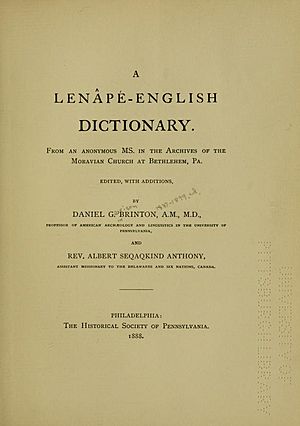Albert Anthony facts for kids
Albert Seqaqkind Anthony was an important Lenape leader and scholar from Canada. He was born around 1839. He helped people understand each other by translating languages. He also worked to save his native Lenape language.
Contents
A Life of Language and Learning
Albert Anthony was a member of the Lenape people. He lived in the Six Nations of the Grand River community in Ontario, Canada. He was very skilled with languages. He could speak his native Munsee language, English, and some Iroquoian languages.
Working with Words
Albert Anthony often worked as an interpreter. This meant he helped people who spoke different languages talk to each other. In 1865, he helped a person named Oronhyatekha. They worked together to create a list of words for the Munsee/Lenape language. This was like making a small dictionary.
Becoming a Priest
Albert Anthony also studied to become a priest. In 1873, he graduated from Huron University College. He became an Anglican priest. After that, he worked as a missionary. He worked with a group called the New England Company. Missionaries often travel to new places to share their beliefs and help communities.
Important Journeys
In 1884, Albert Anthony traveled to Buffalo, New York, in the United States. He went there for a special event. It was the reburial of a famous leader named Red Jacket at Forest Lawn Cemetery.
Saving the Lenape Language
Albert Anthony stopped working as a priest in 1886. He then worked as a farmer for a while. Later, he started an important project. He worked with a scholar named Daniel Garrison Brinton. They worked together to create a dictionary of the Munsee/Lenape language. This was a big job to help preserve his people's language.
He visited Brinton in Philadelphia in 1886 and 1887. This area was part of his ancestors' land, the Delaware Valley. Brinton also asked Anthony about an old Lenape story called the Walam Olum. Anthony believed this story was real and important.
Albert Anthony is also known for a story about how Manhattan got its name. He said it was named after a group of hickory trees. These trees grew in the south of the island. People used the wood from these trees to make bows.


